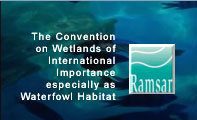


A BRIEF HISTORY OF THE RAMSAR CONVENTION
The Convention on Wetlands of International Importance especially as Waterfowl Habitat (also known as the Ramsar Convention) was signed in Ramsar, Iran, on 2 February 1971, and came into force on 21 December 1975. The Convention provides a framework for national
action and international cooperation for the conservation and wise use of wetlands and their resources.CONVENTION OBJECTIVES AND SCOPE:
Originally emphasizing the conservation and wise use of wetlands primarily to provide a habitat for waterbirds, the Convention has subsequently broadened its scope to address all aspects of wetland conservation and wise
use. This shift in focus reflects the increasing recognition of the importance of wetlands as an ecosystem that contributes to biodiversity conservation and to the well-being of human
communities. According to some estimates, wetlands cover at least 6% of the Earth's land surface, and contribute significantly to the global economy in terms of water supply, fisheries, agriculture, forestry, and tourism.The Ramsar Convention is the only environmental treaty dealing with a particular ecosystem, and currently has 134 Parties. A total of 1229 wetland sites covering 185.9 million hectares are included in the Ramsar List of Wetlands of International Importance. Parties to the Convention commit themselves to: designate at least one site that meets the Ramsar Criteria for inclusion in the Ramsar List and ensure maintenance of the ecological character of each Ramsar site; include wetland conservation within national land-use planning in order to promote the wise use of all wetlands within their territory; establish nature reserves on wetlands and promote training in wetland research and management; and consult with other Parties about Convention implementation, especially with regard to transbounday
wetlands, shared water systems, shared species, and development projects affecting wetlands.Contracting Parties meet every three years to assess progress in implementing the Convention and wetland conservation, share knowledge and experience on technical issues, and plan the next triennium. In addition to the Conference of the Parties (COP), the
Convention's work is supported by a Standing Committee, a Scientific and Technical Review Panel (STRP), and a Secretariat. The Standing Committee includes Regional Representatives of Ramsar's regions (Asia, Oceania, Europe, Africa, North America,
and the Neotropics). Its duties include the supervision of policy implementation by the Secretariat and the administration of the Convention's budget. The STRP provides guidance on key issues related to the application of the Convention. The Secretariat (known as the Ramsar Bureau) deals with the Convention's day-to-day operations, and is housed in the headquarters of IUCN-The World Conservation Union in Gland, Switzerland.
Nimfea Természetvédelmi Egyesület 2004